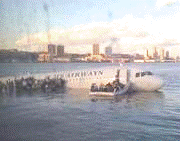Bird Strike Committee Proceedings

Bird Strike Committee-USA/Canada Joint Annual Meeting: 10th (2008)
Date of this Version
8-2008
Document Type
Article
Abstract
DNA barcoding is one of the ‘tools’ used by the Smithsonian Feather Lab to identify birdstrike remains. In a study conducted during fall migration 2006, 48% of the birdstrike cases received for identification from the U.S. Air Force (USAF) and the Federal Aviation Administration (FAA) were submitted for DNA analysis. Using DNA ‘barcoding’ techniques, we identified nearly 68% of those cases to species-level which included 128 species of birds from 14 different Orders, and 12 bats. In the cases where we failed to obtain DNA (approx. 32%), the primary cause was due to fungi growing on the collected samples. Therefore, in 2007 we suggested using alcohol instead of water for swipes, and introduced DNA-fixing FTA® cards for collecting ‘snarge’ samples. These collection changes yielded more samples with minimal fungal contaminants and better success for DNA extractions (76%). In 2008, we optimized our molecular lab protocols and are now using additional primers other than CO1 (‘barcoding’) to achieve 85% success. Combined with the morphological feather identification tools, we have a success rate of nearly 100% in identifying birdstrike remains. This poster presents the entire process of ‘snarge’ sampling with emphasis on the DNA identification process and the improved collecting methods.


Comments
Abstract of poster presentation at Bird Strike Committee USA/Canada Meeting, Lake Mary and Sanford, Florida, August 18–21, 2008.